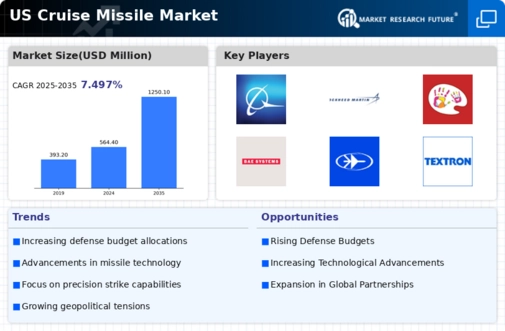Rising Geopolitical Tensions
The cruise missile market is growing due to escalating geopolitical tensions, especially in regions with prevalent military posturing. Nations are increasingly investing in advanced missile systems to enhance their deterrence capabilities. The U.S. has allocated substantial resources to modernize its arsenal, with a reported increase in defense spending by approximately 5% in the last fiscal year. This trend indicates a strong commitment to maintaining military superiority, which directly influences the cruise missile market. As adversaries develop sophisticated countermeasures, the demand for advanced cruise missiles that can penetrate defenses is likely to rise, further driving market expansion. The focus on deterrence and rapid response capabilities is reshaping defense strategies, thereby creating a robust environment for the cruise missile market.
Increased Focus on Naval Warfare
The growing emphasis on naval warfare capabilities significantly influences the cruise missile market. As maritime conflicts become more prevalent, the demand for naval cruise missiles is on the rise. The U.S. Navy has recognized the strategic importance of these systems, leading to increased procurement and development efforts. Recent data suggests that naval defense budgets have risen by approximately 6% in the past year, reflecting a commitment to enhancing maritime strike capabilities. This trend indicates a shift towards more versatile and capable naval platforms, which are essential for modern warfare. The cruise missile market is likely to benefit from this focus, as naval forces seek to deploy advanced missile systems that can operate effectively in diverse environments.
Emerging Threats and Countermeasures
New threats and the corresponding need for effective countermeasures are shaping the cruise missile market. As adversaries develop advanced missile technologies, the U.S. military is compelled to enhance its own capabilities to maintain strategic advantages. This dynamic has led to increased investments in missile defense systems, which are designed to intercept and neutralize incoming threats. The U.S. defense budget for missile defense has seen an increase of approximately 8% in recent allocations, underscoring the urgency of addressing these challenges. The interplay between offensive and defensive capabilities is likely to drive innovation within the cruise missile market, as manufacturers strive to create systems that can operate in contested environments.
Strategic Partnerships and Alliances
Strategic partnerships and alliances are emerging as a crucial driver for the cruise missile market. Collaborative efforts between nations, particularly in defense technology sharing and joint development programs, are fostering innovation and enhancing capabilities. The U.S. has engaged in several defense agreements with allied nations, facilitating the exchange of technology and expertise. These partnerships not only bolster collective defense strategies but also stimulate market growth by expanding the customer base for cruise missile systems. Recent agreements have indicated a potential increase in joint exercises and interoperability initiatives, which may lead to a heightened demand for advanced cruise missiles. As nations work together to address common security challenges, the cruise missile market is likely to see increased activity and investment.
Technological Integration in Defense Systems
The integration of cutting-edge technologies into defense systems is a pivotal driver for the cruise missile market. Innovations such as artificial intelligence, machine learning, and advanced guidance systems are enhancing the precision and effectiveness of cruise missiles. The U.S. military is actively pursuing these technologies to improve targeting accuracy and reduce collateral damage. Reports indicate that investments in defense technology have surged, with a projected increase of 7% in R&D spending over the next five years. This technological evolution not only bolsters the capabilities of existing missile systems but also paves the way for the development of next-generation cruise missiles. Consequently, These advancements are likely to drive significant growth in the cruise missile market.





















Leave a Comment